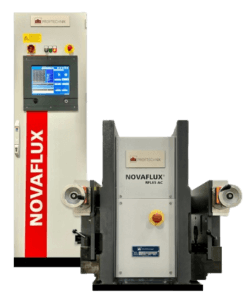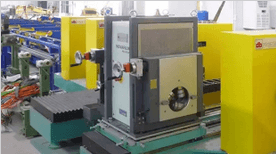
Magnetic Flux Leakage (MFL) testing is particularly effective in the inspection of both surface and subsurface flaws in ferromagnetic materials. Here’s how MFL helps in the detection of these flaws:
1. Principle of Operation:
MFL relies on the principle that magnetic fields are affected by the presence of anomalies such as cracks, corrosion, or other defects in ferromagnetic materials. When a magnetic field is applied to a material, it permeates the material, and any changes in the magnetic permeability due to the presence of flaws lead to the leakage of magnetic flux.
The basic principle of MFL testing is schematically shown in Figure 1, where a magnetizer is applied to magnetize the ferromagnetic specimen into near saturation. The magnetizer can be either a magnet with a ferromagnetic yoke or a magnetizing coil, here The yokes magnetize the test piece at a distance of a few millimeters.

Special test shoes with protected probes located between the yoke arms scan the surface of the test piece by sliding over it. Due to the high permeability of ferromagnetic materials, the magnetic flux is constrained in the material when no defects are presented. In the presence of a defect, the magnetic field leaks into the nearby air and causes the leakage field. A testing system that senses the deviation and displays the reports of this deviation including exact localization information.
2. Detection of Surface Flaws:
Surface flaws, such as cracks or corrosion, disrupt the continuity of the material’s surface. When the magnetic field encounters these disruptions, it leaks out, creating a measurable signal. MFL sensors or detectors are used to identify and analyze these variations in magnetic flux, indicating the presence and location of surface flaws.
3. Detection of Subsurface Flaws:
Subsurface flaws, like internal cracks or corrosion, also influence the magnetic field. The magnetic flux tends to leak into the material and follow the contours of the subsurface anomalies. The MFL sensors are sensitive to these variations in the magnetic field, allowing for the detection and characterization of subsurface flaws with the special test shoes with protected probes that helps in scanning the surface of the test piece by sliding over it.
4. High Sensitivity:
MFL is highly sensitive to changes in magnetic permeability caused by flaws, whether on the surface or below it. This sensitivity enables the detection of small cracks or corrosion pits that may not be visible through visual inspection.
5. Quantitative Data:
MFL provides quantitative data about the size, shape, and location of detected flaws. This information allows for a more accurate assessment of the severity of the flaws and aids in making informed decisions regarding maintenance or repair.
6. Mapping of Flaws:
MFL systems are designed to scan the entire length of the material being inspected. As the sensors move along the surface, they create a detailed map of the magnetic flux variations, effectively mapping the location and extent of surface and subsurface flaws along the entire length of the material.
7. Real-time Inspection:
MFL allows for real-time inspection, providing immediate feedback on the condition of the material. This capability is crucial for industries where continuous operation is essential.
Magnetic Flux Leakage Test with NOVAFLUX
Recognizing the industry’s needs and recognizing the advantages it brings, our esteemed OEM, M/s. Pruftechnik NDT, has introduced the Magnetic Flux Leakage Testing (MFLT) system.

Tailored for the detection of flaws in black and bright metal bars, as well as seamless tubes, this
innovative system from Pruftechnik NDT offers unparalleled precision, ensuring reliable test results. The high-speed testing capability significantly contributes to reducing scrap and material expenses, enhancing operational efficiency.
Salient Features:
- High speed testing
- Detects cracks as small as 0.1 mm in depth
- Cost-saving
- Cost-effective
- User-friendly
- Documented test results
- Compatibility
In conclusion, the MFLT system from Pruftechnik NDT emerges as a groundbreaking solution that not only addresses the specific needs of the industry but also stands out for its exceptional performance. Its ability to deliver reliable results, operate at high speeds and reduce expenses positions it as a method of choice in diverse inspection scenarios. The inherent advantages of efficiency, versatility, and broad applicability make the MFLT system a valuable asset for industries relying on precision testing for their ferromagnetic materials.




